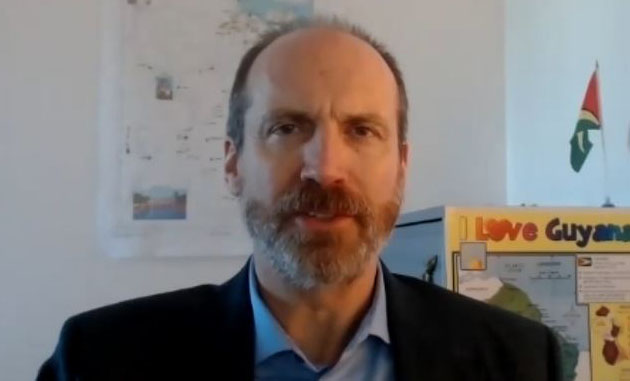In addition to the announcement that the problematic compressor from the Liza Unity FPSO has been replaced and that the new one is functioning optimally at production of 140,000 barrels per day, ExxonMobil also stated that it has paid over US$10 million in fines to the Environmental Protection Agency (EPA) as a penalty for flaring of climate harming gases.
“I am happy to say that we met our expectation of delivering it, installing it and safely starting it in July and we have achieved background flare now on Liza Destiny,” Vice President and Production Manager, Mike Ryan, yesterday told the media at the company’s head office in Duke Street, Kingston, Georgetown.
According to Ryan, since this month, background flaring has been less than one million cubic feet per day.
And while he pointed out that over US$10 million in fines were paid to the EPA for flaring since a policy decision on fines was made last year, he did not divulge the total amount of gas flared. Instead, he said it was “within the permit and within the expectations that we work with the EPA.”
He also noted that while flaring was not at background level, the company had endeavoured to have flaring at the lowest level possible. “While we weren’t at background, we worked extremely hard to minimise the amount of flare that we had and so full compliance with the regulations.”
Background flaring, according to Ryan, has also been achieved on the Liza Unity FPSO and that vessel’s production has also reached its production target of 220,000 barrels per day (bpd). The Liza Unity commenced operations in February of this year.
It would mean that offshore production in the Stabroek Block now stands at 360,000 barrels per day, even as this country prepares for a third FPSO next year.
The Production Manager said that the company will continue to look for ways to test the capacity of the equipment, “within the design of the facility.”
“All compressors are running and injecting all the gas. We are in what you call an ‘endurance run’ right now, so we will run this machine over the next couple of months and what we’ll do is monitor every aspect of that machine, to make sure that it’s acting as we expect… that will inform us to formalise all of our documentation and close out this chapter,” he said of the process that will immediately follow.
ExxonMobil has experienced major problems with the gas compression equipment on Liza Destiny and this had led to environmentally-damaging gas flaring.
Problems developed shortly after production began in December of 2019 and the company had promised to rectify the problem soonest.
President of ExxonMobil Guyana, Alistair Routledge, had informed that the gas compressor failed in the middle of the night on January 27, 2021, when optimisation testing was ongoing and the production level was around 130,000 bpd.
However, he maintained that this was not in any way linked to the malfunction.
Following the malfunction, the gas compressor and other key parts from the FPSO were sent to Germany for repair. A few weeks later, it was announced that logistics for its departure from Germany were being finalised following the successful completion of repairs, upgrades and mechanical testing of the compressor by MAN Energy Solutions, the equipment’s manufacturer, with quality assurance and control by experts from the vessel’s owner SBM Offshore, as well as Exxon.
On April 13, 2021 ExxonMobil announced that its third phase of testing of repaired gas compression equipment on the Liza Destiny had failed and that this had resulted in production being slashed to 30,000 barrels. However, several days later the company announced that it had begun ramping up output and that a solution was at least three months away during which controversial flaring would occur. The gas compressor was sent to Houston, Texas, in the United States for repairs.
Government had also expressed disappointment at ExxonMobil’s failure to resolve the problem with the compressor problem on its oil platform that led to flaring of gas and a steep drop in production.
With the compressor having had to be repaired twice during the early part of this year, the EPA modified the Environmental Permit for the Liza Phase 1 Development Project mandating that Esso Exploration and Production Guyana Limited (EEPGL) pay for gas flaring once it continues beyond a 14-day period.
Ryan yesterday said that with the new compressor installed, the troublesome one would be sent to Germany, upgraded, and kept as a spare. “We are going to take the old one out and bring it back to Germany and upgrade it [to] the same as the one that is offshore now, and operate it as a full spare.”
Costs for the repairs had be borne by the machine’s manufacturer, Mann Energy, and maker of the FPSO, SBM Offshore. “We hold SBM and Mann Energy who is the manufacturer of that compressor, accountable to deliver on their expectations,” Ryan said.





